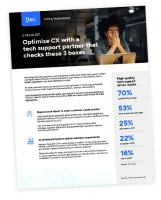Customer support associates have a hard job, and it’s only getting harder as customers’ expectations continue to increase (rightly so, by the way). The turnover rate for contact centre workers is at an all-time high of 38% and it jumped nearly 60% between 2021 and 2022 alone.
Tech support agents may have the toughest jobs of all. Not only are they expected to help customers faster and better than ever, but they handle some of the most complex interactions – generally after customers have tried and failed to fix their problems through automated self-service options. Customers who contact tech support are generally frustrated and unhappy from the outset. They’re angry that their device or subscription isn’t working the way it should, and they’re often under tight deadlines to get it fixed.
Tech support associates bear the brunt of customers’ frustrations, sometimes getting yelled at, berated, or otherwise bullied in the process. Is it any wonder good tech support agents are hard to hold onto?
To retain quality associates, brands need to rethink their approach to tech support. When you optimise your tech support, your front-line associates benefit the most. Investing in their wellness by making their jobs easier and providing a good work environment pays many dividends:
- Better customer experience (CX)
- Improved employee experience (EX)
- Lower attrition
- Longer tenures
Tech support doesn’t have to be a miserable experience. When done well and guided by the right strategy, it can be a positive, proactive, and even a fun process – for your associates and customers alike.
Give customers self-service options
One way to lighten the load for your tech support associates is to empower your customers to help themselves whenever they can. Too often, associates are wasting time performing menial tasks that can easily be diverted to self-service.
Intelligent virtual assistants and chatbots leverage sophisticated AI technology that can assess, triage, and often resolve complex technical support inquiries quickly and escalate to associates only when necessary.
One client we work with, for instance, cut the number of basic inquiries associates handled by 86% by studying their workflows and re-engineering them with proactive self-resolution opportunities, then sharing those findings with a team of human experts who could seamlessly get involved where appropriate.
Automate where it makes sense
Are your tech support associates still doing password resets? That’s so 10+ years ago. If they are, that’s a waste of skilled human labor (not to mention a security liability) and just one example of a task that should be handled by automation.
Take time to examine your customer journey and look for areas where intelligent automation and AI can help. Look for customer-facing actions that can be handled by automation, and also employ automation to help your associates. After all, automation isn’t designed to replace associates; it’s there to make them better equipped and more efficient at their jobs.
Use automation to optimise your back-office processes and knowledgebase, so your associates can quickly find the information they need when they need it. This will enable them to solve frustrated customers’ tech problems more quickly, resulting in happier customers and associates.
Learning and knowledge is another area where automation and AI can make a huge difference. Use AI-powered training to get associates up to speed faster, through customised training (that they can complete on demand) and real-time feedback and coaching. This boosts both CX and EX. A major telecommunications company we worked with saw eNPS and first-call resolution rates rise with our AI-powered training solution, for example.
Use data to be proactive
Tech support associates typically enter an interaction that’s tense from the start. Alleviate some of their stress by proactively trying to prevent technical problems before they happen.
There’s power in your data. Use data analytics to uncover patterns and trends to identify customer pain points. Then use those insights to prevent common technical problems from happening in the first place.
When that doesn’t work and customers need to speak with an associate, empower associates to resolve problems quickly by making co-browsing part of your strategy. Not enough brands use this technique, which lets customers give associates access to view and navigate customers’ screens in real time.
Customers who are upset and just want their problems solved will appreciate the opportunity to hand off control of their machine to a skilled associate who knows how to fix things. And your associates won’t be frustrated from having to repeat or explain complex instructions. It’s a win-win.
Improve employee experience with an expert partner
Improving your tech support approach is key to helping retain associates, but it requires a thoughtful strategy and the right people and tools to execute on it. That’s where working with a the right partner can help.
When you work with a partner that specializes in tech support, customer experience, and employee experience, you’ll gain access to the people and tools you need to keep your associates happy, on the job, and delivering seamless CX.
















